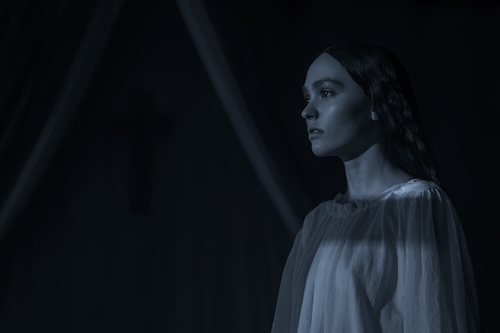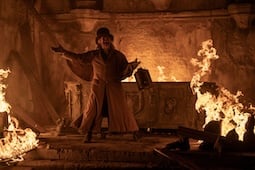
Robert Eggers's new horror movie Nosferatu pulls us into the demonic romance between 19th-century woman Ellen Hutter (Lily-Rose Depp) and the hideous vampire Count Orlok (Bill Skarsgard) whom she has summoned from a long-held dream. The handsomely mounted movie is the third adaptation of Nosferatu, which was itself a loose, unauthorised adaptation of Bram Stoker's seminal 1897 vampire novel Dracula.
The original Nosferatu (subtitled A Symphony of Horror) was a silent film released in 1922 and realised by director F.W. Murnau. It is widely credited as the grandfather of horror cinema, particularly through the looming figure of the menacing Orlok (played by actor Max Schreck). If you're curious to know how Eggers's interpretation differs from Murnau's groundbreaking movie, we're here with a few examples ranging from character treatment to make-up design and story.
NOSFERATU SPOILERS AHEAD
1. It's emphatically Ellen Hutter's story
Eggers's take on Nosferatu begins with a cold open (in every sense of the word) with the lonely Ellen seeking comfort from "any celestial sphere". She then inadvertently summons the monstrous vampire Count Orlok from his centuries-long slumber, setting in motion a hideous union that results in a cathartically horrific climax.
Eggers is explicit in constructing his Nosferatu film around Ellen. In doing so, he's able to probe those elemental Gothic tropes surrounding women's sexuality (evident from sources like Sheridan Le Fanu's 1872 vampire story Carmilla), dramatising the clash between the oft-dismissed Ellen and the bulwark of male-dominated rational science that ruled the day in the early-to-mid 19th century. The movie's power resides in how Ellen willingly perceives her tragic destiny, weaponising her decision to obliterate both herself and Orlok in one fell swoop.
This fascinating narrative strand surrounding Ellen's preternatural abilities is absent in the Murnau iteration. Although the 1922 film showcases Ellen (played by Greta Schröder) in its most famous sequence, as the spindly-fingered Orlok's shadow ascends the staircase, her character feels more like a plot device in the original film. Although she does sacrifice herself in the Murnau version, taking Orlok with her, the Eggers take is much more attuned to the melancholic overtones of destiny and sexuality, having laced in these conceits from the very start.
In that sense, Eggers is maybe drawing more inspiration from Werner Herzog's Nosferatu film, released in 1979. In that film, Isabelle Adjani plays the Ellen equivalent, named Mina Harker (the names revert back to Bram Stoker's Dracula, so Klaus Kinski's Orlok here bears that name instead). Adjani and Herzog play up the character's defiance in the face of evil more explicitly than the Murnau film does, and interestingly, Lily-Rose Depp has cited Adjani's performance in the controversial film Possession (1981) as a key influence on the physicality of her convulsion scenes.
Eggers also makes a lot more of Ellen's marriage to Thomas (Nicholas Hoult), the realtor who brokers the property deal with Orlok and inadvertently sends the Count on his way to Wisborg. It's suggested that Ellen's marriage to Thomas is her redemption from eternal damnation, but the seething Orlok recognises this and sets the plan in motion to tear the husband and wife apart. This results in several of the film's most uncomfortable scenes, particularly when the convulsing, possessed Ellen taunts Thomas with the notion, "You could never please me like he could" ('he' in this case meaning Orlok).
One could argue that Eggers's film is stronger in character development, both in terms of these broader strokes and also the more incidental moments. Thomas is also depicted in a more heroic light, attempting to kill off Orlok in his castle crypt, which is something that didn't happen in the Murnau film when he was portrayed by Gustav von Wangenheim.
2. Count Orlok's design
In the 1922 film, Orlok actor Max Schreck was devoid of any recognisable human attributes, skulking and stalking into the frame with his long fingers, pointed ears, pale face and off-putting bestial nature. The Murnau film plays much more on the front foot with the notion of Orlok being a supernatural creature. Werner Herzog's Nosferatu drew on the original film's design, styling actor Klaus Kinski in pale make-up and prosthetics, although Kinski's take on the character can be seen as more philosophically tragic, a lonely creature isolated in his high tower of endless time, death and destruction.
The way Eggers has designed Count Orlok owes itself to Bram Stoker's Dracula, the inspiration for Nosferatu in all its versions, and the olde-worlde Transylvanian lords from days of yore. The new Orlok invites appalled fascination because we can clearly perceive elements of the man who lost himself to vampirism, from the controversial moustache (an element of Stoker's novel that's often forgotten) to the forelock of hair and the sweeping Transylvanian great coat that gives him a greater sense of bulk.
If Shreck was an ominous presence, Skarsgard's take on the character is decidedly more threatening. Eggers has said that his Orlok is openly modelled as an undead Transylvanian nobleman, which lends a degree of pragmatism amid the supernatural terror.
“The most appreciated contemporary vampire, Edward Cullen from Twilight, is not scary at all,” Eggers tells Gold Derby. “So I wanted to go back to the folklore because the early Balkan and Slavic vampire lore is written by or about people who believed that vampires existed and were terrified of them. So clearly, there must be something scary there. And these early folk vampires looked like rotten corpses — more like how we think of zombies in current cinema. So that was exciting theory.”
Given the new Nosferatu is a sound film, there's also an added advantage in the use of Orlok's voice. The Murnau movie utilised a non-diegetic score to fill in the emotional gaps as to the menace generated by Count Orlok. The Eggers film uses sound, music and the octave-dropping, bass-heavy threat of Skarsgard's Transvylanian intonation to make us feel terrified.
3. The more explicit depiction of the clash between science and the occult
The character of Professor von Franz has been created specifically for the Eggers film, and this offers the director the entryway into a fascinating discussion. Where do we draw the line between objective reality and folklore, the empirical nature of science versus the catalogue of the material on the dark arts that stretches back centuries?
This debate comes about via the dialogue between the Professor, Doctor Wilhelm Sievers (played by Eggers regular Ralph Ineson) and the Hutter's skeptical family friend Friedrich von Harding (Aaron Taylor-Johnson). The Eggers film makes a bigger deal of the elusive search for a cure to Ellen's condition (again, this condition wasn't featured in the 1922 film), and yet as the three men come closer to an answer, they are increasingly disempowered.
Instead, it falls to Professor von Franz to recognise that it is Ellen, and Ellen alone, who holds the power to stop the Nosferatu. As he observes, in a former life, Ellen would have been "A Priestess of Isis" – in other words, revered as a God. Ellen's tragedy is she lives in a world that actively shuns or disbelieves such things. Interestingly, it's said that Dafoe's character is based on that of Albin Grau, the producer of the 1922 film and an avowed practitioner of the occult.
“[Dafoe’s] Von Franz has early-to-mid 19th century learned occult knowledge,” Eggers tells Den of Geek, “and I was thinking about Albin Grau, who was a practicing occultist. "Even though he had some salacious stories when he was doing press that was a little bit cartoony, I think Albin Grau probably did believe in the existence of vampires or psychic vampires.”
Although the Eggers film goes heavy on these dialectical discussions, it does remove one element from the Murnau version that did offer Ellen a note of agency. In the 1922 film, it is Ellen who discovers the book on the Nosferatu, brought back from Orlok's castle by her husband Thomas. It is at that point that she discovers the power is in her hands to end Orlok's reign of terror.
In the Eggers movie, it is the men who discover the book, concealed by Orlok's crazed human puppet Herr Knock (Simon McBurney), and Ellen's growth to agency is depicted more as a slow-burn realisation. She realises that no amount of arguing will hold sway with the arrogant, chauvinistic male community, and inwardly comes to terms with her imminent sacrifice. In that sense, the Eggers film is perhaps a more accurate depiction of the sacrifices made by women during the period depicted in the film.
4. Friedrich's skepticism toward Ellen
The chauvinism of the mid-19th century is best depicted through Friedrich Harding's attitude toward Ellen. Friedrich is best friends with Thomas, as his devout wife Anna (Emma Corrin) is with Ellen. Eggers expands the tragic and horrific canvas by showing how Orlok's insidious influence ultimately destroys the Harding family, including the couple's two children.
The added tragedy comes from Ellen's culpability: via her union with Orlok, she knows what the vampire is capable of, and by initially refusing to give in to his demands, she unwittingly damns the Harding family. This ultimately hastens Ellen's decision to sacrifice herself, end Count Orlok and free herself from the vampiric curse that has stalked her since childhood.
The Friedrich of the Eggers film plays a much more active role in the story. A self-described "rutting goat" and wealthy shipbuilder, he is almost pathologically incapable of sympathising with or understanding Ellen's plight until it is too late. He actively dismisses Ellen and ultimately dies of the plague alongside the corpses of his wife and children.
One could see this as a rebuke of bull-headed arrogance and rationality, and a plea to engage with the more illicit, nebulous aspects of spiritality and folklore. It adds more thematic weight to the storyline, whereas in the Murnau film, Harding is sidelined as an incidental character who bears witness to the unfolding chaos.
5. The colour palette of the visuals
The original Nosferatu is a key text in the German Expressionist Cinema movement of the early 20th century. The movement rejected a depiction of linear reality in favour of heightened, surrealistic visuals, communicating an emotional truth even when the narrative was openly fabulous and fantastical. Key German Expressionist films include the Conrad Veidt-starring chiller The Cabinet of Dr. Caligari (1920), which used painted shadows to heighten a sense of nightmarish mood, and the Fritz Lang masterpieces Metropolis (1927) and M. (1931).
Nosferatu is emblematic of this style, exaggerating its use of light and shade to enhance its folkloric themes of vampirism, the occult and arcane evil. The key image from the first film is the shadow of Count Orlok ascending the staircase as the vampire makes his way toward Ellen's bedroom. Other moments of notable terror include the door opening to Thomas and revealing Orlok gliding his way across the floor – it's an openly surreal moment that nevertheless plucks at those atavistic terrors regarding fairy tales, monsters and the darker side of human nature.
Eggers's film belongs to a different generation and by necessity looks very different. Cinematographer Jarin Blaschke, who has collaborated with Eggers to acclaimed effect on The Witch (2016), The Lighthouse (2020) and The Northman (2022), doesn't deploy a black-and-white aesthetic per se but rather a washed-out, almost monochrome look (think of Emmanuel Lubezki's work on Tim Burton's 1999 chiller Sleepy Hollow). The result is an arresting tableau of escalating terror, a handsomely arranged collage of increasingly deranged deprivation and despair.
Blaschke and Eggers are famous for their use of natural light sources (lamps, candles and fireplaces feature heavily in Nosferatu). In detailing the pivotal castle arrival sequence when Thomas is greeted by Orlok, Blaschke says it was important to suggest Orlok's presence via lighting without making anything too explicit.
“We’re using great distance and darkness outside the staircase, and he’s fragmented," Blaschke tells Variety. "Then we come up, he’s gone again. Then you see him as a true silhouette against the fire.
“That side of the room is front-lit. So it’s even more important that he remained very out of focus. We’re still using these tricks — what’s real, what’s not, where is Orlok? The camera moves around Thomas, leaving Orlok dealing with the papers, and all of a sudden he’s next to Thomas pouring his chalice.”
Are you planning another big-screen date with Count Orlok? Book your tickets for Nosferatu via the link below.












.jpg)
.png)






